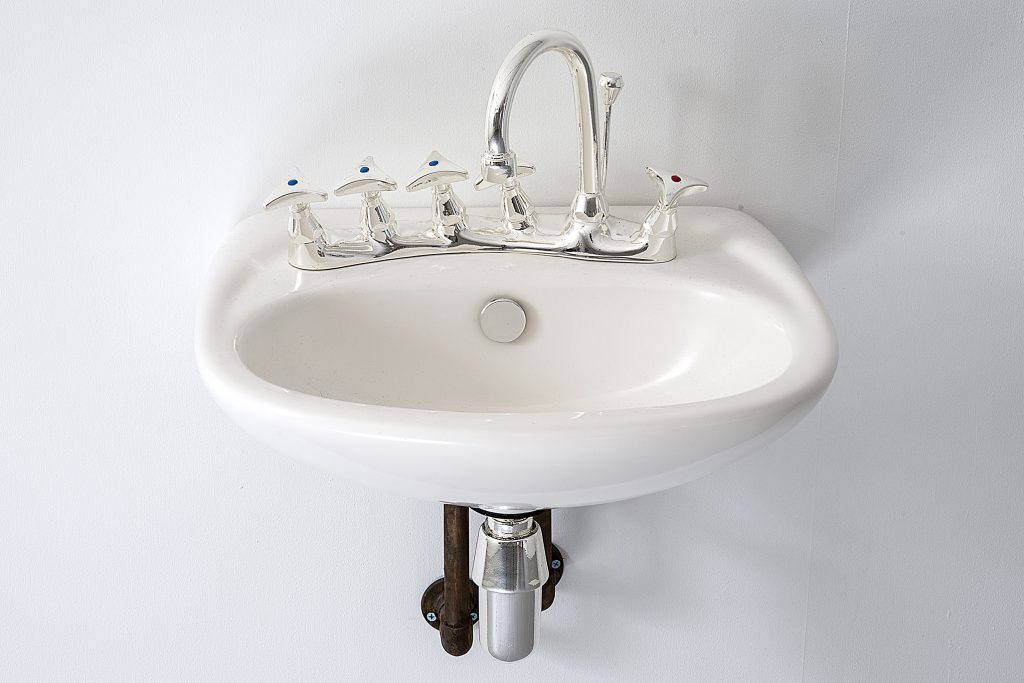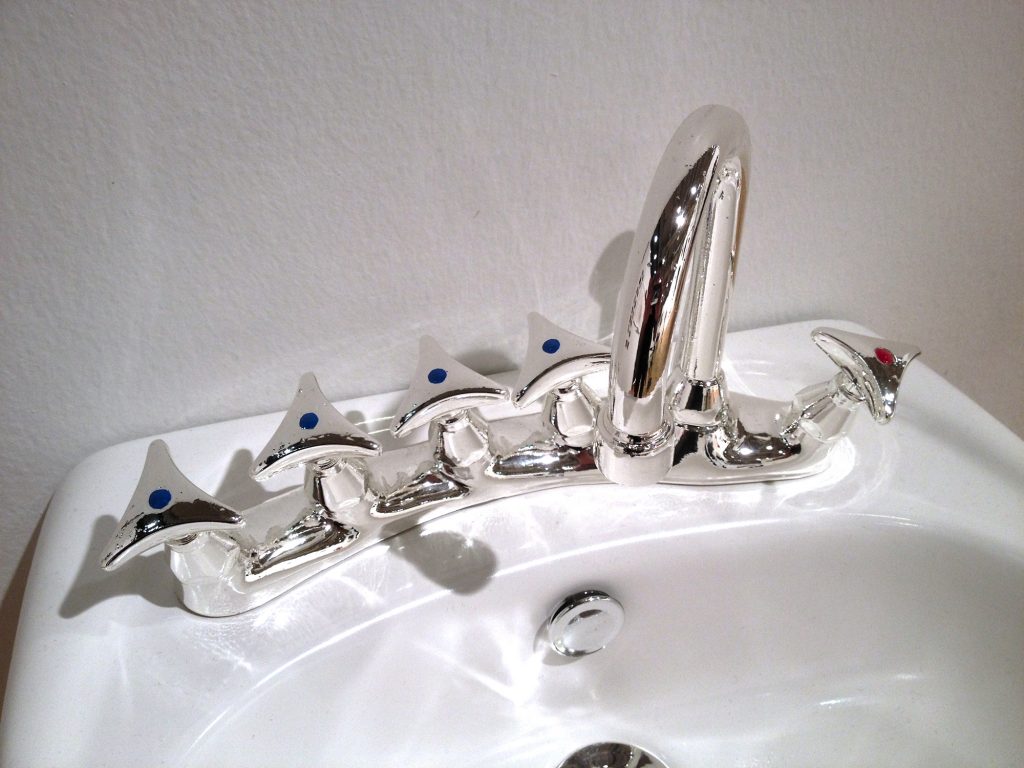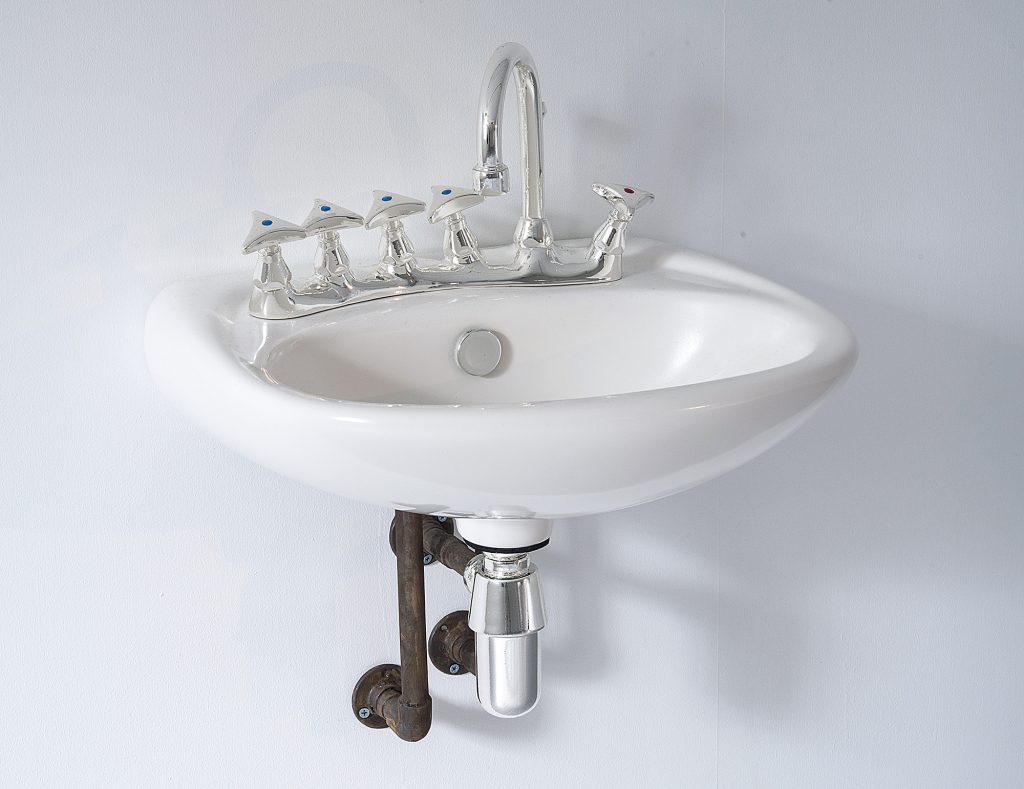Sculpture, 2013
Epoxy, fiberglass, paint, chrome paint and plastic F18
Dimensions: 40 x 40 x 60 cm
Image view: Supermarket, Stockholm Art Fair, Sweden and Hå gamle prestegard, Norway.
The Cruel Radiance By Synnøve Marie Vik
C.W, or Cold War (2013) by Juan André Milanés Benito is a sculpture of a sink, made of epoxy, fiberglass, plastic and chrome paint. It measures 40 x 40 x 60 cm, a realistic size for a sink. A sketch drawing of the sink accompanies the installation. The sink appears to be a traditional porcelain sink with chrome faucet; wall mounted with somewhat rusted pipes. What distinguishes it from any other sink, apart from not functioning, is that it has one tap for hot water and four taps for cold water, as well as a water fountain tap. A black and white photograph by Elliot Erwitt inspires the work. The original photograph depicts an everyday scene from North Carolina in the US in 1950. An African-American man, clad in a white short-sleeved shirt, slacks and a hat, pauses from drinking water from a water fountain. The man glances to his left, at another fountain, somewhat more modern or streamlined, with a cabinet underneath the sink that hides the pipes. Over the fountain the man is drinking from, is an enamel sign spelling “Colored”. Over the other fountain is a sign that says “White”. Knowing its position within the segregated period of modern American history, a strong and deeply troublesome context of both racial and class-based discrimination is deeply embedded in the photograph. Being
a young Cuban man in Norway, Milanés Benito identified with the outsider’s position which the man in Erwitt’s photograph is placed in, and with the political violence portrayed. Using the sink as a protagonist and an updated reminder of past discrimination he draws attention to present-day situations of discrimination. Milanés Benito works consistently with the same materials, constructing works of art that have a startlingly realistic appearance. His work balances uncomfortably on the fine line between reality and fiction. They seem to be ready-mades while always being meticulously crafted replicas, accompanied by sketch drawings that underline the fact that they are models. In C.W he creates an imitation of the sink meant for colored people in the 1950’s photograph, placing an object that belongs to a different context (and time) in a gallery space. Any artwork referencing a fountain cannot escape the history of the ultimate fountain-as-art: Marcel Duchamp placing a urinal in the gallery, thus giving it a new position as art. Milanés Benito twists this situation, placing a replica, an independent artwork, in the gallery. C.W invites us to ponder on how this mock “displacement” changes the gallery space, as in fact, it is not a displacement of a sink, but a sculpture of a sink that quite naturally belongs there. The parallel to Duchamp is even more noteworthy seen as how Milanés Benito merges the question of hierarchy of objects in the art world with the hierarchies of social institutions in today’s geopolitical situation. Who is allowed to partake in the benefits of our democratic society? Milanés Benito changes a well-known object ever so slightly, just enough for the object to transmit a certain uneasiness: The sink has four cold-water taps as well as a drinking fountain tap, a twist that compels us to look closely at the object in question. While the title of the work, Cold War, is a historical reference to a political standstill, a violent deadlock, and cold water is a strong metaphor for the enforcing of a standstill. To be cold-blooded is to not let your emotions cloud your judgment and carry you away. In today’s political situation, the discussion of integration of immigrants might be one way to understand both the cold water and cold war metaphors in C.W. The refugee crises following the wars and conflicts in the Middle East and several African countries is one of the most pressing issues in European politics, and immigration and concerns with integration are high on the political agenda in Norway. Norwegian immigration laws are tightening, the situation for asylum seekers waiting for their applications to be processed is dire. The European Union decided as of March 2016, as an attempt to prevent people from fleeing to Greece by boat, that they would send those who fled to Greece back to Turkey; as if the brutality of the cold waters of the Mediterranean weren’t enough. The sleekness of the sculpture and its realistic appearance gives it a certain glow, while the four cold-water taps disturb the familiarity of the object, causing an uncanny effect.
The sculpture appears to be real, but C.W invites us to question our known reality, and what produces reality. The question of who the insider is and who remains on the outside of society is oftentimes decided upon by relying on existing infrastructure. These infrastructures compel us to move on, not taking notice of our surroundings and fellow citizens. C.W encourages us to ask how something as ordinary as a faucet can be a discriminatory instrument and invites us to see our surroundings anew, to uncover such instruments in our own lives. In his book The Right to Look: A Counter-history of Visuality (2011), visual culture theorist Nicholas Mirzoeff has formulated a theory of a counter history of visuality in colonial history, revealing how power creates a standard operating procedure: an aesthetic that appeals to us, that seems “right”, and thus encourages us to move on, since ‘there is nothing to see here’. This aesthetic is what he considers to be the regime that controls our visual culture. By claiming ‘a right to look’, we can conceptualize these forms of visuality and establish a counter-visuality through images, gauging the political implications of their aesthetic, he argues. Cold War is an eloquent reminder of the discrimination of those who are different than the majority, its polished appearance eliciting the cruel radiance of witnessing history manifold times repeating itself. It requires us to pause and reflect on what we know to be true really is true, simply by looking and asking: How can this be?
Bibliography: Mirzoeff, Nicholas. 2011. The Right to Look: A Counter history of Visuality. Duke University Press Books.



